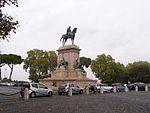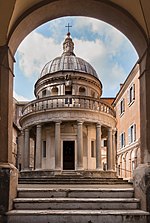Aqua Traiana

The Aqua Traiana (later rebuilt and named the Acqua Paola) was a 1st-century Roman aqueduct built by Emperor Trajan and inaugurated on 24 June 109 AD. It channelled water from sources around Lake Bracciano, 40 kilometers (25 mi) north-west of Rome, to Rome in ancient Roman times but had fallen into disuse by the 17th century. It fed a number of water mills on the Janiculum, including a sophisticated mill complex revealed by excavations in the 1990s under the present American Academy in Rome. Some of the Janiculum mills were famously put out of action by the Ostrogoths when they cut the aqueduct in 537 during the first siege of Rome. Belisarius restored the supply of grain by using mills floating in the Tiber. The complex of mills bears parallels with a similar complex at Barbegal in southern Gaul.
Excerpt from the Wikipedia article Aqua Traiana (License: CC BY-SA 3.0, Authors, Images).Aqua Traiana
Via Garibaldi, Rome Municipio Roma I
Geographical coordinates (GPS) Address Nearby Places Show on map
Geographical coordinates (GPS)
| Latitude | Longitude |
|---|---|
| N 41.8886 ° | E 12.4641 ° |
Address
Fontana Dell'Acqua Paola (Fontanone)
Via Garibaldi
00120 Rome, Municipio Roma I
Lazio, Italy
Open on Google Maps









